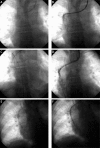Transcutaneous intravascular transposition of a permanent dialysis catheter
- PMID: 25337180
- PMCID: PMC4198644
- DOI: 10.5114/wiitm.2014.44136
Transcutaneous intravascular transposition of a permanent dialysis catheter
Abstract
Permanent catheters are used to provide long-lasting access for long-term dialysis therapy in certain patients when creating an arteriovenous fistula between their own vessels is not possible, when there are contraindications for fistula creation or when the expected lifetime of the patient is short. We present the case of a patient with terminal renal insufficiency treated with hemodialysis for 5 years. Due to post-thrombotic changes and venous stenosis resulting from long-term cannulation with dialysis catheters, the replacement catheter was inserted through the previously used canal and transcutaneous intravascular catheter transposition was performed.
Keywords: endovascular catheter transposition; hemodialysis; permanent catheters.
Figures

Similar articles
-
Implantation of permanent jugular catheters in patients on regular dialysis treatment: ten years' experience.J Vasc Access. 2001 Apr-Jun;2(2):68-72. doi: 10.1177/112972980100200209. J Vasc Access. 2001. PMID: 17638264
-
[Access for starting kidney replacement therapy: vascular and peritoneal temporal access in pre-dialysis].Nefrologia. 2008;28 Suppl 3:105-12. Nefrologia. 2008. PMID: 19018747 Spanish.
-
Association of hemodialysis central venous catheter use with ipsilateral arteriovenous vascular access survival.Am J Kidney Dis. 2012 Dec;60(6):983-9. doi: 10.1053/j.ajkd.2012.06.014. Epub 2012 Jul 21. Am J Kidney Dis. 2012. PMID: 22824354 Free PMC article.
-
Innovations in vascular access for hemodialysis.Kidney Int. 2019 May;95(5):1053-1063. doi: 10.1016/j.kint.2018.11.046. Epub 2019 Mar 4. Kidney Int. 2019. PMID: 30922666 Review.
-
Do central venous catheters have advantages over arteriovenous fistulas or grafts?J Nephrol. 2006 May-Jun;19(3):265-79. J Nephrol. 2006. PMID: 16874685 Review.
References
-
- Kumano S, Itatani K, Shiota J, et al. Strategies for the creation and maintenance of reconstructed arteriovenous fistulas using the forearm basilic vein. Ther Apher Dial. 2013;17:504–9. - PubMed
-
- Praga M, Merello JI, Palomares I, et al. Type of vascular access and survival among very elderly hemodialysis patients. Nephron Clin Pract. 2013;124:47–53. - PubMed
-
- Leś J, Wańkowicz Z. Methods of central vascular access for haemodialysis. Anaesthesiol Intensive Ther. 2013;45:171–6. - PubMed
-
- Cetinkaya R, Odabas AR, Unlu Y, et al. Using cuffed and tunnelled central venous catheters as permanent vascular access for hemodialysis: a prospective study. Ren Fail. 2003;25:431–8. - PubMed
Publication types
LinkOut - more resources
Full Text Sources
Other Literature Sources
